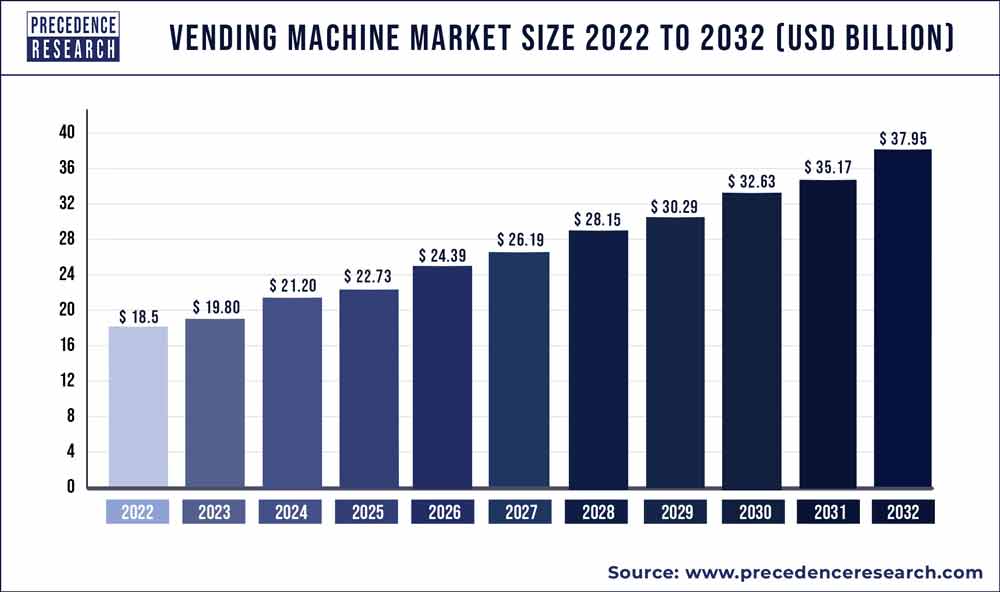The global vending machine market size was exhibited at USD 19.80 billion in 2023 and is expected to hit around USD 37.95 billion by 2032, poised to grow at a CAGR of 7.50% during the forecast period from 2023 to 2032. #vendingstatistics
Key Takeaways
- North America contributed more than 45% of revenue share in 2022.
- Asia Pacific is estimated to expand the fastest CAGR between 2023 and 2032.
- By type, the beverages vending machine segment has held the largest market share of 42% in 2022.
- By type, the food vending machine segment is anticipated to grow at a remarkable CAGR of 7.9% between 2023 and 2032.
- By application, the hotels and restaurants segment generated over 40% of revenue share in 2022.
- By application, the public places segment is expected to expand at the fastest CAGR over the projected period.
- By technology, the automatic machine segment generated over 55% of revenue share in 2022.
- By technology, the smart machine segment is expected to expand at the fastest CAGR over the projected period.
Vending Machine Market in the U.S. 2023 To 2032
The U.S. vending machine market size was valued at USD 6.24 billion in 2023 and is projected to reach USD 11.95 billion by 2032, growing at a CAGR of 7.50% from 2023 to 2032.
North America has held the largest revenue share of 45% in 2022. North America dominates the vending machine market due to a combination of factors. The region benefits from a robust infrastructure, high consumer demand for convenience, and the early adoption of innovative vending technologies. The mature and well-established vending industry in North America has embraced cashless payments, touchless interfaces, and diversified product offerings. Additionally, a culture of on-the-go snacking and a large workforce further drive market growth. These elements collectively position North America as a key player in the vending machine market, holding a major share due to its technological advancements and consumer-oriented approach.
Growth Factors
- Continuous innovation in vending machine technology enhances user experience and operational efficiency.
- Growing consumer preference for healthier snacks and beverages fuels the demand for healthier vending options.
- The rise in digital payments and mobile wallets encourages cashless transactions in vending machines.
- Vending machines offering personalized product choices cater to diverse consumer preferences.
- Eco-friendly vending machines with energy-efficient features align with environmental concerns.
- Touchless selection and payment methods boost hygiene and safety.
- Internet of Things connectivity allows real-time monitoring and maintenance.
- Machines offering a wide range of items from electronics to fresh food appeal to a broader audience.
- Increased urban population density creates more vending machine placement opportunities.
- Machines at airports, train stations, and healthcare facilities serve a captive audience.
- Vending machines in convenience stores expand shopping options for customers.
- Vending machines provide easy access to snacks and beverages for employees.
- Data analytics enable businesses to tailor offerings based on customer preferences.
- Compliance with food safety standards is crucial for vending operators.
- Expansion into developing regions opens up new growth opportunities for vending machine companies.
The vending machine industry is witnessing a significant surge in demand, largely propelled by the widespread embrace of cashless payment systems and the increased emphasis on health and safety. Cashless payments have revolutionized consumer purchasing habits, as digital transactions gain prominence owing to their convenience and security features. Vending machines equipped with features like card readers and mobile wallet compatibility offer a seamless and hygienic buying experience, making transactions quicker and more efficient, and thus appealing to a broader audience.
Additionally, the increased emphasis on health and safety, particularly in light of recent global events, has highlighted the need to minimize physical contact with surfaces. Vending machines have responded by incorporating touchless interfaces, contactless delivery methods, and improved sanitation practices, instilling consumer confidence in the safety and hygiene of these vending solutions. As health and safety concerns persist, vending machines have evolved into a reliable and adaptable retail option, positioning them for sustained growth in a post-pandemic world.
Source: Precedence Research / Vending Market















